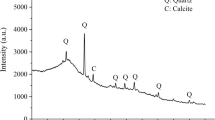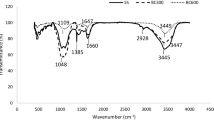Abstract
Tropical peat soils present higher ash content than those generated at temperate climate areas. Therefore, this study evaluated the characteristics of a Brazilian organic soil (OS), commercialized as peat, as well as its capacity in removing Cr(VI) from contaminated waters. The OS is composed of 35.5 wt% of organic matter and 56 wt% of inorganic fraction (ash), which is formed by minerals and phytoliths rich in silica (29.2 wt%) and alumina (23.6 wt%). The Cr(VI) removal tests were carried out in batch and column systems using OS and solutions of Cr(VI) prepared with distilled water and groundwater. Batch tests revealed that the organic substances in the OS caused the reduction of Cr(VI) to Cr(III), with an efficiency depending on solution pH. At pH 5.0 the Cr(VI) removal was 0.45 mg g−1 in 24 h; whereas at pH 2.0, this removal increased to 1.10 mg g−1. Since this redox reaction is very slow, the removal of Cr(VI) at pH 5.0 increased to around 2 mg g−1 after 5 days. The removal of Cr(VI) was more effective in the column tests than in the batch test due to the greater solid/solution ratio, and their half-lives were 4.4 and 26.2 h, respectively. Chemical analysis indicated that Cr(VI) was reduced by the humic substances of OS, followed by the precipitation and/or adsorption of Cr(III) into the organic and inorganic components, as anatase. The presence of Cr(III) increased the stability of anatase structure, avoiding its transformation into rutile, even after being heated at 800 °C/2 h.








Similar content being viewed by others
References
Ajouyed O, Hurel C, Ammari M et al (2010) Sorption of Cr(VI) onto natural iron and aluminum (oxy)hydroxides: effects of pH, ionic strength and initial concentration. J Hazard Mater 174:616–622. https://doi.org/10.1016/j.jhazmat.2009.09.096
Alleoni LRF, Mello JWV, Rocha WSD (2009) Eletroquímica, adsorção e troca iônica do solo. In: SBCS (ed) Química e mineralogia do solo—Parte II—Aplicações. Minas Gerais, Viçosa
ASTM (2014) D 653—14: soil, rock, and contained fluids. ASTM, West Conshohocken
Balan C, Bilba D, Macoveanu M (2008) Removal of cadmium (II) from aqueous solutions by sphagnum moss peat: equilibrium study. Env Eng Manag J 7:17–23
Balan C, Volf I, Bulai P, Bilba D, Macoveanu M (2012) Removal of Cr(VI) form aqueous environment using peat moss: equilibrium study. Env Eng Manag J 11:21–28
Banks MK, Schwab AP, Henderson C (2006) Leaching and reduction of chromium in soil as affected by soil organic content and plants. Chemosphere 62:255–264. https://doi.org/10.1016/j.chemosphere.2005.05.020
Barlett RJ, James BR (1988) Mobility and bioavailability of chromium in soils. In: Nriagu JO, Nierboer E (eds) Chromium in the natural environment. Wiley, New York, pp 267–304
Bellifa A, Pirault-Roy L, Kappenstein C, Choukchou-Braham A (2014) Study of effect of chromium on titanium dioxide phase transformation. Bull Mater Sci 37(3):669–677
Benites VM, Madar B, Machado PLOA (2003) Extração e fracionamento quantitativo de substâncias húmicas do solo: um procedimento simplificado de baixo custo. Comun Técnico 16:1–7
Blowes DW, Ptacek CJ, Jambor JL (1997) In-situ remediation of Cr(VI)-contaminated groundwater using permeable reactive walls: laboratory studies. Environ Sci Technol 31:3348–3357. https://doi.org/10.1021/es960844b
Blowes DW, Ptacek CJ, Benner SG et al (2000) Treatment of inorganic contaminants using permeable reactive barriers. J Contam Hydrol 45:123–137. https://doi.org/10.1016/S0169-7722(00)00122-4
Brown P, Gill S, Allen SJ (2000) Metal removal from wastewater using peat. Water Res 34:3907–3916. https://doi.org/10.1016/S0043-1354(00)00152-4
Cameron CC, Esterle JS, Palmer CA (1989) The geology, botany and chemistry of selected peat-forming environments from temperate and tropical latitudes. Int J Coal Geol 12:105–156. https://doi.org/10.1016/0166-5162(89)90049-9
Camargo AO, Moniz AC, Jorge JA, Valadares JMAS (2009) Métodos de análise química, mineralógica e física de solos do Instituto Agronômico de Campinas - Boletim técnico 106. Instituto Agronômico do Estado de São Paulo, Campinas
Chen CY, Lan GS (2000) Preparation of mullite by the reaction sintering of kaolinite\rand alumina. J Eur Ceram Soc 20:2519–2525
Chimner RA, Ewel KC (2005) A tropical freshwater wetland: II. production, decomposition, and peat formation. Wetl Ecol Manag 13:671–684. https://doi.org/10.1007/s11273-005-0965-9
Crist RH, Martin JR, Choniko J, Crist DR (1996) Uptake of metals on peat moss: an ion exchange process. Environ Sci Technol 30:2456–2461
Dević G (2015) An assessment of the chemical characteristics of early diagenetic processes in a geologically well-defined brown coal basin. Energy Sources Part A Recover Util Environ Eff 37:2559–2566. https://doi.org/10.1080/15567036.2012.724147
Gardea-Torresdey JL, Tang L, Salvador JM (1996) Copper adsorption by esterified and unesterified fractions of sphagnum peat moss and its different humic substances. J Hazard Mater 48:191–206
Genutchen MT van, Alves WJ (1982) Analytical solutions of the one-dimensional convective dispersive solute transport equation, Boletim Té. US Department of Agriculture
Góes MA, Luz AB, Possa MV (2004) Amostragem. In: Luz AB, Sampaio J, Almeida SLM (eds) Tratamento de minérios, 4°. CETEM, Rio de Janeiro, pp 18–50
Gu B, Chen J (2003) Enhanced microbial reduction of Cr(VI) and U(VI) by different natural organic matter fractions. Geochim Cosmochim Acta 67:3575–3582. https://doi.org/10.1016/S0016-7037(03)00162-5
Haberhauer G, Feigl B, Gerzabek MH, Cerri C (2000) FT-IR Spectroscopy of organic matter in tropical soils: changes induced through deforestation. Appl Spectrosc 54(2):221–224
Henryk K, Jarosław C, Witold Ż (2016) Peat and coconut fiber as biofilters for chromium adsorption from contaminated wastewaters. Environ Sci Pollut Res 23:527–534. https://doi.org/10.1007/s11356-015-5285-x
Hesse PR (1971) A textbook of soil chemical analysis. Chemical Publishing Co., New York
Hsu TC, Guo GL, Chen WH, Hwang WS (2010) Effect of dilute acid pretreatment of rice straw on structural properties and enzymatic hydrolysis. Bioresour Technol 101:4907–4913. https://doi.org/10.1016/j.biortech.2009.10.009
Huang PJ, Chang H, Yeh CT, Tsai CW (1997) Phase transformation of TiO2 monitored by thermo-Raman spectroscopy with TGA/DTA. Thermochim Acta 297:85–92. https://doi.org/10.1016/S0040-6031(97)00168-8
Huang SW, Chiang PN, Liu JC et al (2012) Chromate reduction on humic acid derived from a peat soil—exploration of the activated sites on HAs for chromate removal. Chemosphere 87:587–594. https://doi.org/10.1016/j.chemosphere.2012.01.010
Janaki V, Kamala-Kannan S, Shanthi K (2015) Significance of Indian peat moss for the removal of Ni(II) ions from aqueous solution. Environ Earth Sci 74:5351–5357. https://doi.org/10.1007/s12665-015-4547-8
Joosten H (2016) Changing paradigms in the history of tropical peatlands research. In: Osaki M, Tsuji N (eds) Tropical peatland ecosystems. Springer, Tokyo, pp 33–48
Kiehl EJ (1979) Manual de Edafologia—relações solo-planta. Ceres, São Paulo
Klavins M, Purmalis O, Rodinov V (2013) Peat humic acid properties and factors influencing their variability in a temperate bog ecosystem. Estonian J Ecol 62(1):35–52. https://doi.org/10.3176/eco.2013.1.04
Krumins J, Klavins M, Seglins V (2012) Comparative study of peat composition by using FT-IR spectroscopy. Mater Sci Appl Chem 26:106–114
Liu W, Ni J, Yin X (2014) Synergy of photocatalysis and adsorption for simultaneous removal of Cr(VI) and Cr(III) with TiO2 and titanate nanotubes. Water Res 53:12–25. https://doi.org/10.1016/j.watres.2013.12.043
Liu Y, Mou H, Chen L et al (2015) Cr(VI)-contaminated groundwater remediation with simulated permeable reactive barrier (PRB) filled with natural pyrite as reactive material: environmental factors and effectiveness. J Hazard Mater 298:83–90. https://doi.org/10.1016/j.jhazmat.2015.05.007
Machado JMC, Oliveira LMCPE, Kamogawa MY (2011) Reciclagem do crômio de resíduos químicos provenientes da determinação de carbono oxidável em fertilizantes orgânicos. Quim Nova 34:131–134
Mak MSH, Lo IMC (2011) Influences of redox transformation, metal complexation and aggregation of fulvic acid and humic acid on Cr(VI) and As(V) removal by zero-valent iron. Chemosphere 84:234–240. https://doi.org/10.1016/j.chemosphere.2011.04.024
Miyazawa M, Pavan MA, Oliveira EL de et al (2000) Gravimetric determination of soil organic matter. Braz Arch Biol Technol 43:475–478. https://doi.org/10.1590/S1516-89132000000500005
Mulligan CN, Yong RN, Gibbs BF (2001) Remediation technologies for metal-contaminated soils and groundwater: an evaluation. Eng Geol 60:193–207. https://doi.org/10.1016/S0013-7952(00)00101-0
Music S, Maljkovic M, Popovic S, Trojko R (1999) Formation of chromia from amorphous chromium hydroxide. Croat Chem Acta 72:789–802
Nolan NT, Seery MK, Pillai SC (2009) Spectroscopic investigation of the anatase-to-rutile transformation of sol–gel-synthesized TiO2 photocatalysts. J Phys Chem C 113:16151–16157. https://doi.org/10.1021/jp904358g
Olazabal MA, Nikolaidis NP, Suib SA, Madariaga JM (1997) Precipitation equilibria of the chromium(VI)/iron(III) system and spectrospcopic characterization of the precipitates. Environ Sci Technol 31:2898–2902. https://doi.org/10.1021/es9700865
Page SE, Rieley JO, Wüst R (2006) Lowland tropical peatlands of Southeast Asia. In: Martini IP, Cortizas AM, Chesworth W (eds) Peatlands: evolution and records of environmenal and climate changes. Elsevier, Amsterdam, pp 145–172
Palmer CD, Plus RW (1994) Natural attenuation of hexavalent chromium in groundwater and soils. USEPA, Washington, DC
Priyantha N, Lim LBL, Wickramasooriya S (2016) Adsorption behaviour of Cr(VI) by Muthurajawela peat. Desalin Water Treat 57:16592–16600. https://doi.org/10.1080/19443994.2015.1081835
Russel JD (1987) Infrared methods. In: Wilson MJ (ed) A handbook of determinative methods in clay mineralogy. Blackie & Sons, London, pp 133–173
Schnitzer M (1972) Chemical, spectroscopic, and thermal methods for the classification and characterization of humic substances. In: Povoledo D, Golterman HL (eds) Proceedings of international meeting on humic substances. PUDOC, Wageningen, pp 293–310
Schwartz FW, Zhang H (2003) Fundamentals of groundwater. Wiley, New York
Sharma DC, Forster CF (1993) Removal of hexavalent chromium using sphagnum moss peat. Water Res 7:1201–1208
Sharma P, Bihari V, Agarwal SK et al (2012) Groundwater contaminated with hexavalent chromium [Cr (VI)]: a health survey and clinical examination of community inhabitants (Kanpur, India). PLoS One 7:3–9. https://doi.org/10.1371/journal.pone.0047877
Stevenson FJ (1994) Humus chemistry: genesis, composition, and reaction. Wiley, New York
Thiruvenkatachari R, Vigneswaran S, Naidu R (2008) Permeable reactive barrier for groundwater remediation. J Ind Eng Chem 14:145–156. https://doi.org/10.1016/j.jiec.2007.10.001
Ulmanu M, Anger I, Fernández Y et al (2008) Batch chromium(VI), cadmium(II) and lead(II) removal from aqueous solutions by horticultural peat. Water Air Soil Pollut 194:209–216. https://doi.org/10.1007/s11270-008-9709-9
USDA (United States Department of Agriculture) (1999) Soil taxonomy, 2nd edn. USDA, Washington, DC
USEPA (United States Environmental Protection Agency) (1989) Evaluation of groundwater extraction remedies. EPA Office of Emergency and Remedial Responses, Washington, DC
USEPA (United States Environmental Protection Agency) (1991) EPA method 2186—determination of dissolved hexavalent chromium in drinking water, groundwater and industrial wastewater effluents by ion chromatography. United States Environmental Protection Agency, Washington, DC
USEPA (United States Environmental Protection Agency) (2017) Chromium in drinking water. https://www.epa.gov/dwstandardsregulations/chromium-drinking-water. Accessed 24 Apr 2017
Wada K and Okamura Y (1977) Measurements of exchange capacities and hydrolysis as means of characterizing cation and anion retentions by soils. Proceedings of the international seminar on soil environment and fertility management in intensive agriculture, Tokyo-Japan, pp 811–815
WHO (World Health Organization) (2017) Guidelines for drinking-water quality, 4th edn. World Health Organization, Geneva
Wilkin RT, Su C, Ford RG, Paul CJ (2005) Chromium-removal processes during groundwater remediation by a zerovalent iron permeable reactive barrier. Environ Sci Technol 39:4599–4605. https://doi.org/10.1021/es050157x
Wilkin RT, Acree SD, Ross RR et al (2014) Fifteen-year assessment of a permeable reactive barrier for treatment of chromate and trichloroethylene in groundwater. Sci Total Environ 468–469:186–194. https://doi.org/10.1016/j.scitotenv.2013.08.056
Wittbrodt PR, Palmer CD (1996) Reduction of Cr (VI) by soil humic acids. Eur J Soil Sci 47:151–162
Wu Y, Zhang Y, Qian J, Xin X, Hu S, Zhang S, Wei J (2017) An exploratory study on low-concentration hexavalent chromium adsorption by Fe (III)-cross-linked chitosan beads. R Soc Open Sci 4:170905. https://doi.org/10.1098/rsos.170905
Wüst RAJ, Bustin RM, Lavkulich LM (2003) New classification systems for tropical organic-rich deposits based on studies of the Tasek Bera Basin, Malaysia. Catena 53:133–163. https://doi.org/10.1016/S0341-8162(03)00022-5
Yolcubal I, Akyol NH (2007) Retention and transport of hexavalent chromium in calcareous karst soils. Turk J Earth Sci 16:363–379
Zehra T, Lim LBL, Priyantha N (2015) Removal behavior of peat collected from Brunei Darussalam for Pb(II) ions from aqueous solution: equilibrium isotherm, thermodynamics, kinetics and regeneration studies. Environ Earth Sci 74:2541–2551. https://doi.org/10.1007/s12665-015-4273-2
Zengguang X, Yanqing W, Hui X (2013) Optimization of a PRB structure with modified chitosan restoring Cr(VI)-contaminated groundwater. Environ Earth Sci 68:2189–2197. https://doi.org/10.1007/s12665-012-1902-x
Zhang J, Xu Y, Li W et al (2012) Enhanced remediation of Cr(VI)-contaminated soil by incorporating a calcined-hydrotalcite-based permeable reactive barrier with electrokinetics. J Hazard Mater 239–240:128–134. https://doi.org/10.1016/j.jhazmat.2012.08.039
Zhilin DM, Schmitt-Kopplin P, Perminova IV (2004) Reduction of Cr(VI) by peat and coal humic substances. Environ Chem Lett 2:141–145. https://doi.org/10.1007/s10311-004-0085-4
Acknowledgements
The authors would like to acknowledge Prof. Dr. José Guilherme Franchi for the donation of the peat samples from São Luiz do Paraitinga (SP) and the anonymous referees for their valuable comments.
Author information
Authors and Affiliations
Corresponding author
Rights and permissions
About this article
Cite this article
dos Santos, M.M.A., Shinzato, M.C. & de Freitas, J.G. Characterization and evaluation of a tropical peat for the removal of Cr(VI) from solution. Environ Earth Sci 77, 515 (2018). https://doi.org/10.1007/s12665-018-7703-0
Received:
Accepted:
Published:
DOI: https://doi.org/10.1007/s12665-018-7703-0




